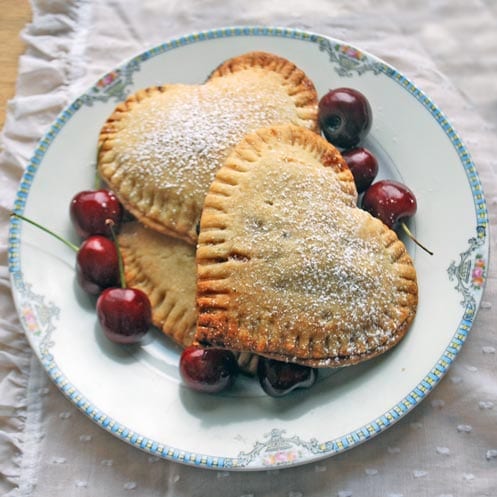Heart-shaped cookie cutters are the key to making your yummy Valentine’s Day treats even more special! These sweet treats are perfect for dessert, class parties or just to share with your family this February 14th.
Sweetheart Cherry Pies

Ingredients:
Pie dough
Fresh cherries, chopped
Ricotta cheese
Sprinkle of sugar
1 TBSP butter, melted
Instructions:
1. Preheat oven to 375 degrees. Line your baking sheet with parchment paper.
2. Roll out your pie dough (I like to do this between 2 sheets of plastic wrap). Cut out shapes with cookie cutter.
3. Sprinkle and stir the sugar with the chopped cherries in a bowl.
4. Lay out your heart cut outs on the baking sheet. Spoon on some fresh ricotta cheese, then spoon on the cherries. Lay down the top dough, seal to press with a fork.
5. Brush the top with melted butter.
6. Bake for about 15 minutes or until mini hearts are golden brown. The baking time will largely depend on the thickness of your pastry dough and your oven. Just keep close watch.
7. Cool for 5 minutes, then transfer to a wire rack. Dust with powdered sugar if desired.
~Recipe courtesy of CakeStudent.com
Chocolate Dipped Krispie Hearts

Ingredients:
3 tablespoons butter, plus extra for buttering pans
1 (10-ounce) package regular marshmallows or 4 cups miniature marshmallows
6 cups crisp rice cereal
12 ounces semisweet chocolate (baking chocolate or chocolate chips)
Valentine’s sprinkles
Directions:
1. Butter a large rimmed baking sheet or two 9X13-inch pans. Set aside.
2. In a large saucepan over medium heat, melt the butter. Add the marshmallows and stir until melted and smooth. Remove from the heat and stir in the krispies. Press the mixture into the prepared pan(s) and set aside to cool for about an hour.
3. Using a 2 to 3-inch heart-shaped cookie cutter, press the cutter into the cooled krispie treats, removing the heart-shaped treats to a wax paper or parchment paper-lined baking sheet or work space.
4. In a microwave-safe bowl, melt 12 ounces chocolate chips on 50% power for one minute. Stir. Continue this process until the mixture is melted and smooth but not overheated.
5. If desired, push a cookie or lollipop stick into the bottom of the krispie treats (optional). Holding one side of the krispie heart (or using the stick as a handle), dip half of the krispie treat into the melted chocolate and then transfer to the wax paper or parchment paper.
6. While the chocolate is still warm on the krispie heart, sprinkle festive Valentine (or other) sprinkles onto the chocolate. Let the treats cool completely and the chocolate harden before serving, about 1-2 hours.
~Recipe courtesy of MelsKitchenCafe.com
Hidden Heart Cake

For the red cake:
Ingredients:
All purpose flour – 2 cups
Baking powder – 1 tsp
Butter – 2 sticks
Granulated sugar – 1 cup
Eggs – 4 large
Vanilla extract – 2 tsp
Salt – 3/4 tsp
Red food coloring – 1/2 tsp
Instructions:
1. Pre heat the oven to 350 F. Grease and line a 9x5x3 loaf pan.
2. In a bowl, beat the butter and sugar until it’s light and fluffy.
3. Add the eggs one or two at a time, along with vanilla and beat again. Scrape the bowl after each addition.
4. Sift in the flour, baking powder and salt. Add little by little and fold gently. The batter will be very thick.
5. Add the red color and beat again lightly until the color is mixed well to the batter.
6. Transfer the batter to the loaf pan and bake for 50 – 60 minutes.
7. The cake is done when a tooth pick or skewer comes out clean. Cool in the pan for 15 minutes and then remove to a cooling rack. Once the cake is completely cool, cling wrap the cake and keep it in the refrigerator.
8. Before starting the chocolate cake, remove the red cake from the refrigerator and slice the cake evenly. Use a heart cookie cutter to cut out hearts from each slice of the cake and set aside.
For the chocolate cake:
Ingredients:
All purpose flour – 1 1/2 cups
Cocoa powder – 1/2 cup
Baking powder – 1 tsp
Butter – 2 sticks
Granulated sugar – 1 1/4 cup
Eggs – 4 large
Vanilla extract – 2 tsp
Salt – 3/4 tsp
Instant coffee granules – 1/2 tsp (optional)
Instructions:
1. Pre heat the oven to 350 F. Grease and line a 9x5x3 loaf pan or a slightly larger loaf pan.
2. In a bowl, beat the butter and sugar until it’s light and fluffy.
3. Add the eggs one or two at a time, along with vanilla and beat again. Scrape the bowl after each addition.
4. Sift in the flour, baking powder, cocoa powder, coffee granules and salt. Add little by little and fold gently.
5.Fill 1/4 of the greased loaf pan with the chocolate batter and tap well to even it out.
6. Now place the hearts vertically next to each other on the batter. Pack them close. Leave a bit of gap at both corners for the chocolate batters to flow through and hide the hearts.
7. After the hearts are placed, add the remaining chocolate batter over the hearts and around the hearts.
8. Fill the pan, and tap gently so that the batter flows all around the hearts.
9. Bake in the pre heated oven for 50-60 mins.
10. The cake is done when a tooth pick or skewer comes out clean. Cool in the pan for 15 minutes and then remove to a cooling rack.
11. Frost the cake as you wish and decorate with heart-shaped candy.







